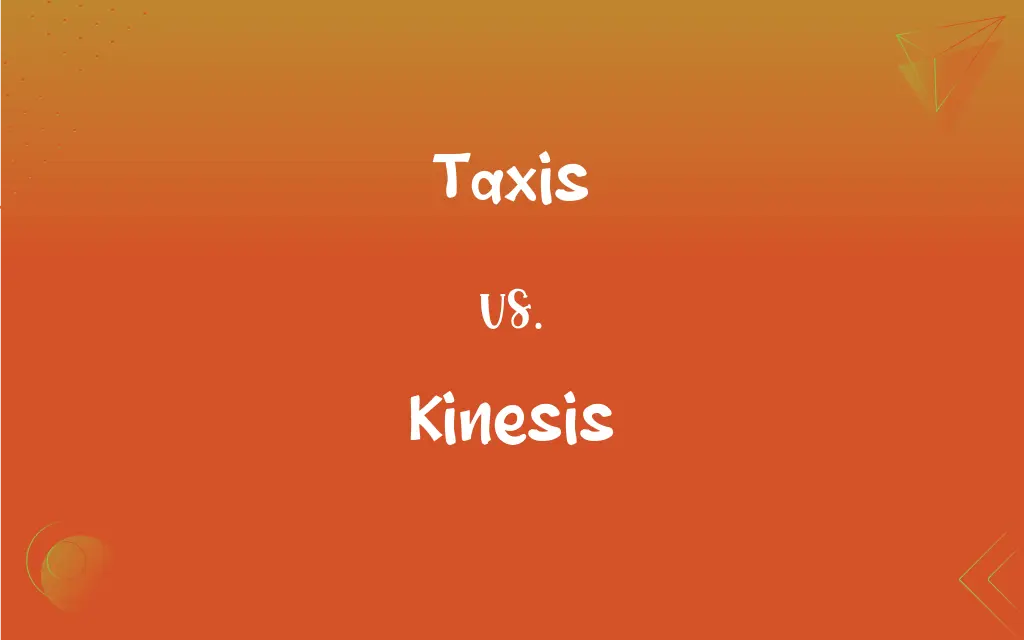Taxis vs. Kinesis: What's the Difference?
Edited by Aimie Carlson || By Harlon Moss || Updated on October 19, 2023
Taxis refers to directed movement in response to a stimulus, while kinesis refers to undirected movement due to stimulus intensity.

Key Differences
Taxis represents a movement that is directed either towards or away from a stimulus. For example, when an organism moves towards light, it is exhibiting positive phototaxis. On the other hand, kinesis is about random, non-directional movement as a result of a stimulus. Instead of being attracted to or repelled by the stimulus, the organism changes its activity rate.
In taxis, the direction of movement is significant and is directly related to the source of the stimulus. Such behavior can be seen in many organisms, including bacteria moving toward sugars (chemotaxis) or moths flying toward a light source. Kinesis, in contrast, does not result in any directed movement towards or away from the stimulus. Instead, the organism may just increase or decrease its overall activity levels based on stimulus intensity.
Taxis can be classified further into positive and negative taxis. Positive taxis are movements towards a stimulus, while negative taxis are movements away from a stimulus. Kinesis, however, does not have such classifications because its movement is undirected. Organisms in a kinesis response may move more quickly or slowly, but there's no particular direction to their movements.
In terms of evolution and adaptation, taxis can be viewed as a more advanced response, guiding organisms towards favorable conditions or away from harmful ones. Kinesis, although simpler, can still provide adaptive value. An organism exhibiting kinesis might move more in unfavorable conditions, increasing the chance of finding a more suitable environment.
Comparison Chart
Type of Movement
Directed
Undirected
ADVERTISEMENT
Response
Towards or away from a stimulus
Varies in activity level
Classification
Positive (towards) or negative (away)
None (just increased or decreased)
Purpose
Move to favorable conditions
Increase chance of finding favorable conditions
Example
Moths towards light (phototaxis)
Woodlice increase activity in dry conditions
Taxis and Kinesis Definitions
Taxis
Organismal movement that's stimulus-directed.
Fish might display rheotaxis, swimming against the current.
ADVERTISEMENT
Kinesis
Movement that is undirected but varies in response to environmental factors.
Pill bugs alter their kinesis levels based on dryness, becoming more mobile in arid conditions.
Taxis
The adaptive movement of an organism in response to a specific cue.
Positive gravitaxis allows some algae to move upwards in water columns.
Kinesis
A non-directional behavioral change influenced by stimulus strength.
Kinesis in worms can be observed when soil moisture changes, altering their movement rates.
Taxis
A behavioral response of organisms, dictated by stimulus direction.
The sunflower exhibits heliotaxis, turning to face the sun.
Kinesis
Random movement of organisms influenced by stimulus intensity.
In response to increased humidity, woodlice display kinesis by becoming more active.
Taxis
Directed movement towards or away from a stimulus.
Many bacteria exhibit taxis, moving towards nutrients.
Kinesis
A change in activity rate due to environmental stimulus, without direction.
Silverfish increase their kinesis when exposed to light, moving more erratically.
Taxis
A locomotory response where direction is influenced by stimulus source.
Some insects avoid light through negative phototaxis.
Kinesis
Movement or activity of an organism in response to a stimulus such as light.
Taxis
(Biology) The responsive movement of a free-moving organism or cell toward or away from an external stimulus, such as light.
Kinesis
(biology) The movement of an organism in response to an external stimulus.
Taxis
(Medicine) The moving of a body part by manipulation into normal position, as after a dislocation, fracture, or hernia.
Kinesis
(physics) Any energy that creates/controls movement.
Kinesis
(philosophy) The force driving life forward.
Kinesis
A movement that is a response to a stimulus but is not oriented with respect to the source of stimulation
Kinesis
The undirected response of organisms to the intensity of a stimulus.
Ants may display kinesis when exposed to increased heat, moving without a clear direction.
FAQs
What is kinesis?
Kinesis is the undirected movement of an organism that varies in intensity due to a stimulus.
How is taxis different from kinesis?
Taxis is directed towards or away from a stimulus, while kinesis is undirected and varies based on stimulus intensity.
What is taxis?
Taxis is the directed movement of an organism towards or away from a stimulus.
And negative taxis?
Negative taxis is movement away from a stimulus.
How about an example of kinesis?
In drier conditions, woodlice might increase their activity levels, an example of kinesis.
Can plants exhibit taxis?
Yes, some plants, like sunflowers, exhibit heliotaxis, turning to face the sun.
What does positive taxis mean?
Positive taxis is movement towards a stimulus.
How does chemotaxis differ from phototaxis?
Chemotaxis is movement in response to chemical stimuli, while phototaxis is in response to light.
Are taxis and kinesis innate behaviors?
Generally, both are innate responses to environmental stimuli.
Is taxis more advanced than kinesis?
Evolutionarily, taxis can be seen as more specific and directed, but both provide adaptive advantages.
How do researchers study taxis and kinesis?
Through experiments, often using mazes or gradients of stimuli to observe organismal responses.
Why are taxis and kinesis important for survival?
They help organisms find favorable conditions or avoid harmful ones, aiding in survival and reproduction.
Can you give an example of taxis?
Yes, moths moving towards a light source is an example of positive phototaxis.
Are taxis and kinesis mutually exclusive?
No, an organism can exhibit both taxis and kinesis in response to different stimuli.
How is kinesis adaptive for organisms?
Kinesis can increase the chances of an organism finding a more favorable environment.
Are there types of kinesis like there are for taxis?
Kinesis doesn't have specific types like taxis, but rather is characterized by changes in activity levels.
Is kinesis always random?
While kinesis is undirected, the changes in activity levels are in response to environmental stimuli.
Can an organism display both positive and negative taxis?
Yes, depending on the stimulus, an organism can move towards or away from it.
Can environmental changes influence taxis and kinesis?
Yes, changes in the environment can alter both the direction and intensity of these behaviors.
Do all organisms show taxis or kinesis?
No, but many organisms exhibit these behaviors as adaptive responses to their environment.
About Author
Written by
Harlon MossHarlon is a seasoned quality moderator and accomplished content writer for Difference Wiki. An alumnus of the prestigious University of California, he earned his degree in Computer Science. Leveraging his academic background, Harlon brings a meticulous and informed perspective to his work, ensuring content accuracy and excellence.
Edited by
Aimie CarlsonAimie Carlson, holding a master's degree in English literature, is a fervent English language enthusiast. She lends her writing talents to Difference Wiki, a prominent website that specializes in comparisons, offering readers insightful analyses that both captivate and inform.































































